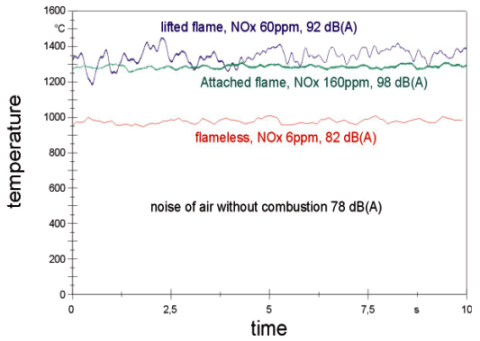-
What is the effect of flameless operation upon combustion noise?
Date posted:
-
-
Post Author
espadmin
1. Background
Combustion generated noise ([GLOSS]Combustion roar[/GLOSS] – CF6) arises from the turbulent reactions taking place within flames. Any approach that reduces turbulence levels and combustion intensity within a combustion reaction may be expected to reduce the [GLOSS]Sound power[/GLOSS] produced by a flame.
This combustion file gives an indication of the reductions in [GLOSS]Sound pressure levels[/GLOSS] (and hence in [GLOSS]Sound power levels[/GLOSS]) that have been observed by switching from a conventional flame mode to a [GLOSS]Flameless combustion[/GLOSS] mode (CF171).
Flameless combustion will also affect the way a combustor responds to imposed acoustic or regular aerodynamic fluctuations. It will therefore also influence the production of combustion driven oscillations and gas turbine [GLOSS]Hum[/GLOSS] (see CF176). The latter aspects are not considered further in this combustion file.
2. The Measured effect of Flameless Operation on Combustion Roar
[GLOSS]A-weighted sound pressure levels[/GLOSS] measured inside a test furnace fired by an experimental gas burner, that could be operated either in flame mode (burner stabilised flame or [GLOSS]Lifted flame[/GLOSS]) or in flameless mode, are reported in Figure 1. Switching from the burner-stabilised flame to flameless operation reduced the sound pressure levels by some 16dB, corresponding to a reduction in combustion sound power by at least a factor of 40. The sound pressure levels measured in flameless operation were low enough to be affected by other noise sources, measured as just 4dB lower when fuel flow was cut off, and are therefore an indication of the very low noise achieved. This phenomenon was systematically observed in large burners as well: in flameless firing, the audible, typical combustion roar is definitely suppressed.
For completeness, NOx measurements in different combustion modes have also been reported in Figure 1, together with temperature fluctuations measured 250 mm from the burner with a miniaturised thermocouple probe in the test furnace.
The thermocouple was not able to respond to higher frequencies directly involved in the production of combustion noise. It was, however, just able to follow the low frequency pulsations in the “lifted flame” regime, which is an intermediate case characterised by lower frequency fluctuations.

Figure 1 – Noise levels, NOx and local temperature for flame and flameless modes
Sources
[1] J. G. Wünning – Flammlose Oxydation von Brennstoff – Doktorarbeit, RWTH Aachen, 1996
